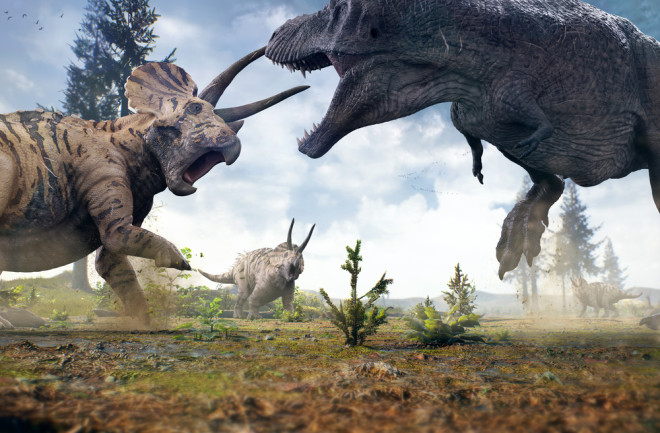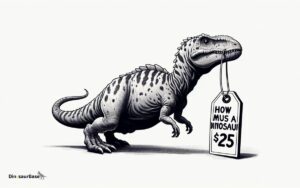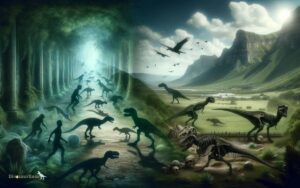Which Dinosaur Was a Carnivore? Discover the Mighty Predators!
The Tyrannosaurus rex was a carnivorous dinosaur. This fearsome predator roamed the earth during the late Cretaceous period.
Dinosaurs have long fascinated both scientists and the public, and the carnivorous varieties often steal the spotlight due to their fearsome reputations. The Tyrannosaurus rex, often dubbed T-Rex, stands out as one of the most well-known and iconic of these meat-eating giants.
With its massive jaws, formidable teeth, and powerful build, the T-Rex has become synonymous with the term ‘carnivore. ‘ Its presence in popular culture solidifies its legacy as a prehistoric predator. Beyond the T-Rex, other carnivorous dinosaurs like Velociraptor, Spinosaurus, and Allosaurus also capture our imagination, each with its own unique hunting methods and adaptations that allowed them to thrive in their respective environments millions of years ago. Understanding these ancient creatures provides insight into the diversity of life on Earth and the evolutionary history of modern-day animals.

The Age Of Dinosaurs
The Age of Dinosaurs spans millions of years. This time saw the rise and fall of many prehistoric predators. Let’s travel back to when these giants roamed the Earth. We’ll explore which dinosaurs were carnivores during the Triassic, Jurassic, and Cretaceous periods.
Triassic Period
The dawn of the dinosaur age started with the Triassic period. It’s the era when dinosaurs began to appear. Here are some notable carnivores from that time:
- Coelophysis – a slender, fast hunter
- Herrerasaurus – one of the earliest dinosaurs
Jurassic Period
The Jurassic period saw the diversification of dinosaur species. Gigantic carnivores emerged. Some ruled the land, such as:
- Allosaurus – the formidable predator
- Ceratosaurus – with a distinctive horn on its snout
Cretaceous Period
The final chapter for the dinosaurs was the Cretaceous period. It introduced some of the most famous carnivores. Tyrannosaurids and raptor dinosaurs were among them:
- Tyrannosaurus Rex – the iconic mighty hunter
- Velociraptor – a swift and intelligent killer
These predators displayed remarkable adaptive radiation. They evolved with specialized skills to survive. Their hunting strategies and physical features set them apart. The following table highlights key traits:
| Dinosaur | Period | Notable Feature |
|---|---|---|
| Coelophysis | Triassic | Lightweight body, quick |
| Allosaurus | Jurassic | Sharp teeth, strong jaws |
| Tyrannosaurus Rex | Cretaceous | Massive size, fierce bite |
| Velociraptor | Cretaceous | Intelligence, speed |
Each carnivore adapted to its environment. They thrived in their respective periods before the mass extinction event. This adaptation helped dinosaurs dominate the prehistoric world for over 160 million years.
Defining Carnivorous Behaviors
Dinosaurs that ate meat dominated the prehistoric world with fierce behaviors. These giants ruled by hunting and scavenging. Let’s explore the diets and physical features that made them successful predators.
Dietary Habits Of Ancient Predators
Carnivorous dinosaurs thrived on diets rich in other creatures. Their habits included:
- Hunting – Tracking and chasing prey.
- Scavenging – Feasting on leftovers from other predators.
- Fishing – Some species caught fish with sharp teeth.
These diets could vary widely, with some species preferring certain prey over others.
Physical Traits Aiding Carnivorous Lifestyle
Distinctive physical traits evolved in carnivorous dinosaurs, such as:
| Trait | Function |
|---|---|
| Sharp teeth | Tearing flesh. |
| Powerful legs | Running fast to catch prey. |
| Large claws | Grabbing and holding onto targets. |
Each trait played a key role in making these dinosaurs formidable hunters.
Iconic Carnivorous Dinosaurs
Picture the prehistoric world, teeming with life. Among the giants are the fierce carnivores. These dinosaurs dominated their territories, hunting prey with terrifying efficiency. They are the legends of ancient Earth, feared and admired through time. Let’s unveil some of the most iconic meat-eating dinosaurs ever to walk the planet.
Tyrannosaurus Rex: The King of the Tyrant LizardsTyrannosaurus Rex: The King Of The Tyrant Lizards
Tyrannosaurus Rex, often called T-Rex, stands at the peak of prehistoric fame. This titan zooecistor wielded a pair of formidable jaws. With teeth as long as bananas, T-Rex tore through flesh and bone.
- Name: Tyrannosaurus Rex
- Period: Late Cretaceous
- Diet: Carnivorous
- Notable features: Huge skull, powerful legs, and massive tail
Imagine a predator weighing up to 14 tonnes, stalking through the ancient world. The T-Rex was a true powerhouse, its every step causing the ground to tremble.
Velociraptor: The Swift ThiefVelociraptor: The Swift Thief
The Velociraptor lived up to its name, moving with remarkable speed. Famous for its cunning and agility, this dinosaur was a master hunter.
| Characteristic | Detail |
|---|---|
| Name | Velociraptor |
| Period | Late Cretaceous |
| Diet | Carnivorous |
| Special Traits | Sharp claws, fast runner |
Despite its size, smaller than a modern turkey, Velociraptor was no less terrifying. Its sharp, retractable claw on each foot was a deadly weapon, perfect for puncturing prey. Intelligent and swift, Velociraptors hunted in packs, outsmarting larger dinosaurs with their strategic prowess.
Both T-Rex and Velociraptor left a significant mark on history. Their fossils tell stories of power, survival, and the circle of prehistoric life. These carnivorous dinosaurs symbolize the raw essence of nature: red in tooth and claw.

Credit: www.mydinosaurs.com
Lesser-known Predatory Giants
When we think of carnivorous dinosaurs, T-Rex often steals the show. Yet, there were many other fearsome predators in the prehistoric world. Let’s shed some light on lesser-known predatory giants that once roamed the Earth.
Allosaurus: The Different Lizard
The dinosaur known as Allosaurus, meaning “different lizard,” was a formidable beast.
- Period: Late Jurassic
- Location: North America
- Distinguishing Features: Sharp claws and serrated teeth
Less famous than the T-Rex, this dinosaur was a top predator of its time. Scientists view Allosaurus as a keen hunter that could take down large prey.
Spinosaurus: The Spine Lizard
Imagine a dinosaur with a gigantic sail on its back. Enter the formidable Spinosaurus, or “spine lizard”.
| Period | Location | Distinguishing Features |
|---|---|---|
| Early Cretaceous | Africa | Long spines on back forming a sail |
Its diet likely included fish and smaller dinosaurs. Spinosaurus is a unique dinosaur with its semiaquatic lifestyle, a contrast to the usual land-dwelling carnivores.
Hunting Techniques And Behaviors
Long ago, immense carnivorous dinosaurs roamed the Earth. They had incredible ways to chase and catch their prey. Sharp claws and strong jaws were just a few of their tools. Let’s explore how these magnificent beasts hunted to survive.
Pack Hunting Vs. Solitary Predators
Dinosaurs either hunted together or alone. This was a big part of their success. Pack hunters could take down bigger animals. Solitary predators relied on surprise and speed.
- Velociraptors worked in groups. They outsmarted their prey.
- Tyrannosaurus rex usually hunted alone. It used its strong bite to capture food.
Anatomical Features For Hunting Success
Dinosaurs had unique body parts that made them fierce hunters. Sharp teeth, powerful legs, and keen senses were vital.
| Dinosaur | Feature | Function |
|---|---|---|
| Allosaurus | Clawed hands | Grasping prey |
| Spinosaurus | Long snout | Catching fish |
| Giganotosaurus | Sharp teeth | Slicing meat |

Credit: www.discovermagazine.com
Exploring The Evidence
What gives away a dinosaur’s diet from millions of years ago? Strong evidence lies with fossils and advanced science. Let’s dig into how we know if a dinosaur was a carnivore.
Fossil Records And Bite Marks
Bones are like history books, telling stories of ancient meals. Researchers look closely at fossilized remains to spot clues about a dinosaur’s diet. Sharp teeth often mean meat was on the menu. We see certain dinosaurs with blade-like chompers, ideal for slicing flesh.
Another clue comes from bite marks found on prey bones. Through bite marks, we can match the tooth patterns to the possible predator. Here’s where it gets more interesting:
- Tyrannosaurus rex: Known for its massive, powerful jaws and serrated teeth.
- Velociraptor: Owned curved, razor-like teeth perfect for tearing.
Modern Technology In Paleontological Studies
Science today uses high-tech tools to uncover the past. CT scans reveal hidden details in fossils without harming them. They show us the shape and structure of a dinosaur’s skull, hinting at muscle strength and feeding habits.
Chemical analysis of fossils can also find traces of last meals. By looking at the carbon isotopes in bones, we might know if a dinosaur ate plants or other animals. Examples of dinosaurs studied this way include:
| Dinosaur | Eating Habit Indicator |
|---|---|
| Allosaurus | Isotope analysis suggests a strict meat diet. |
| Spinosaurus | Fossil studies hint at a fish-based diet. |

Credit: www.amazon.com
Conclusion
Exploring the ancient world of dinosaurs reveals fascinating insights into their diets. Carnivorous dinosaurs, like the iconic Tyrannosaurus rex, were top predators. Their impressive hunting abilities and sharp teeth left a mark on prehistoric ecosystems. Remembering these magnificent beasts gives us a glimpse into our planet’s rich history, long before humans arrived.
The legacy of these carnivores endures through ongoing scientific discovery and public imagination.






